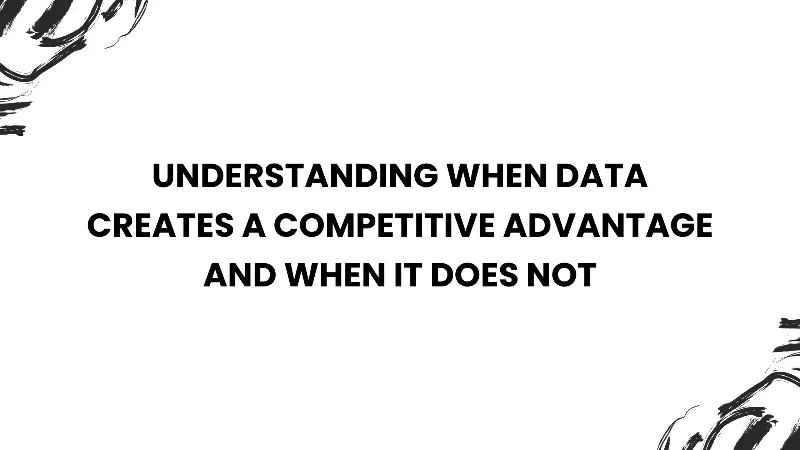Understanding When Data Creates a Competitive Advantage and When It Does Not

Check out OLake, our latest open source offering for replicating databases to lakehouses.
Data has become increasingly important in the modern business landscape, with many companies leveraging it to gain an edge over their competition.
Understanding when data creates a competitive advantage and when it doesn't is essential for any business that wants to maximize its potential.
Understanding Data and Its Applications
Data refers to information that has been collected and analyzed for decision-making purposes. It can include customers' demographics, sales figures, market trends, social media platform activity data and product usage data.
Customer data-enabled learning is possible when you effectively capture wide attributes about your customer.
More and more data is being generated every day - according to Statista, almost 100 zettabytes of data were produced in 2022 alone.
When used correctly, data creates a competitive advantage and provides valuable insights into customer behavior and preferences, and even potential new opportunities.
Companies can use customers' data insights to make informed decisions and develop strategies that will give them an edge over the competition. Yes, an unbeatable competitive edge is possible with data.
Gathering diversified and more data from more customers can help a business get better. By looking at what customers are saying, a company can find out what they can do better and make their products or services even better.
Data can also show a company new groups of people who might like what they offer. By using this information, a business can make smart choices and this way data creates competitive advantage.
Metrics to Track Customer Loyalty
Maximizing the Value of Your Data
Today's customers' translates to producing huge amounts of data and since data produced by one user data will most likely be different from other users, it's important to consider what kind of insights it will provide.
Is it granular enough to provide meaningful insights and customer data change? Can it help you identify new opportunities or better understand your customer base? Understanding the potential of your data is the first step in determining if data creates competitive advantage.
It's also important to consider the quality of the data. Questions like these need to be answered: Is it accurate and up-to-date? Are there any gaps or inconsistencies that could affect the accuracy of the insights?
Moreover, you should consider the cost of collecting and storing the data. This is key for unlocking an unbeatable competitive edge through data.
Analyzing the Key Factors that Create a Competitive Edge
In some cases, data can be used to identify market trends or potential new opportunities that your competitors may not be aware of. Identifying and leveraging these factors can give a competitive advantage to many executives and team members.
For example, if you have access to customers' data that reveal their preferences that are not being addressed by the competition, you may be able to gain a competitive advantage by offering products or services that meet those needs.
This is a practical use of data-enabled learning, i.e using data to learn something non-obvious.
Data can give your business a significant advantage over others. By looking at what your customers like and don't like, and customers' willingness to pay, you can find ways to make your products or services even better. And by using data, you can find new groups of people who might like what you offer.
This information helps you make smart decisions and be one step ahead of the competition. Business leaders also use data to find ways to save money or be more efficient.
By using this information, they can reduce costs and make more profits, giving them a strong advantage over their competitors. Data is a powerful tool, and by using it well, a business can have an unbeatable edge in today's market.
How Datazip helped Topmate increase customer engagement
Strategies for Leveraging Data to Gain an Edge
Once you have identified the factors that could create a competitive advantage, it's time to develop a strategy to use customer data. Leveraging your strongest competitive position may involve re-evaluating your existing products and services, creating new ones, or using data to identify potential new markets or customer segments.
It's also important to inculcate data-enabled learning for more customers' data-driven decisions and consider how the data you can gather be used to optimize operations and increase efficiency.
Current users' data can help companies make smart decisions about pricing, marketing, and product improvements, and get competitors' strategies reverse-engineered.
By analyzing historical and latest data from individual customers, companies can learn about what their customers like and how they behave. By looking at similar data from more customers, companies can see market trends and develop strategies to take advantage of these trends. This can give a company an unbeatable edge over competitors.
In this era of information systems, there are many tools - like machine learning algorithms, social media platforms, google maps, and other online platforms that can help companies gather and make sense of this data.
By using these tools, companies can get insights into more customers' data and even send out personalized recommendations.
This is how data creates a competitive advantage - by giving companies a better understanding of their customers and the market.
Harnessing the Power of Using Customers' Data in Business
Data creates competitive advantage and using unique customer data in business can be a cherry on top.
It ultimately garners towards identifying future customers' needs and preferences of the same customers as well as new customers more accurately, tailoring messaging and pricing strategies more effectively, and making smarter decisions about where to invest resources.
It can also reduce costs by optimizing processes and improving efficiency.
Customer-generated data can also be used to gain a competitive edge. By analyzing customer data, businesses can gain insights into their competitors' strategies and use this information to develop more effective marketing campaigns.
Differentiating one customer from another through data can be used to identify new opportunities for growth and innovation by recognizing patterns and behaviors. By leveraging data, many success stories can be reverse-engineered and businesses can stay ahead of the competition and remain competitive in the marketplace.
Machine learning is a powerful tool that can help businesses gain new insights and make better decisions.
By leveraging data-enabled learning, companies can harness the power of customer data capabilities to create more accurate models that inform their business strategies.
With the abundance of customer-generated data, businesses can use machine learning to identify patterns and trends that can help them reach more customers and provide better experiences.
This in turn drives increased customer engagement and ultimately, more business growth. Mastering machine learning tools would also mean having defensible barriers for your business.
Downsides of Over-Reliance on Data in Business
Keep in mind that sometimes going over the board with these insights can make you grossly overestimate the advantage provided as well. More customers equal more data but more data might not be equal to more value in terms of business goals.
Relying too heavily on data can lead to oversimplified assumptions and tunnel vision.
As much as the competitive advantage provided is justified, data can sometimes be unreliable or incomplete, leading to inaccurate conclusions due to its complex production process.
Some executives assume that data can also be subject to bias, which might lead to skewed results. Receiving more data also means that you need to be aware of any potential biases that may be present in the data and take steps to mitigate them.
Sometimes more data confers misinterpretations, leading to incorrect conclusions and leaving few or no substitutes to incur losses or lose the market in the worst-case scenario.
Understanding When Data Does Not Create a Key Advantage
In some cases, customer-generated data you can gather may not provide enough or the right kind of insights to give your business a durable competitive advantage. This could be due to the data being insufficiently granular or there is an instance of user data depreciation or it simply does not provide the kind of insights necessary for decision-making.
In these cases, customer data capabilities are diminished, and relying on traditional methods such as market research may be more beneficial.
Some investors assume that more customers' data is equal to more insights and hence more growth but if the data is not providing the insights ACTUALLY needed to make informed decisions, then it is not allowing you to build competitive defenses.
Customer data should be used in conjunction with other methods such as market research to ensure that decisions are based on the most comprehensive information available.
Making the Best out of Your Data Without Becoming Over-Reliant on It
Data can be an invaluable resource for businesses, but it's important to remember that it should be used as part of a holistic approach. Use customer data relative to inform decisions, but also consider other factors such as customer feedback and industry trends. This will help ensure that your decisions are based on reliable information and are not overly dependent on data.
It's important to remember that data can be subject to bias and errors, so it's important to double-check the accuracy of the data before making any decisions.
Customer data should be used in combination with other methods of analysis, such as qualitative research, to ensure that decisions are based on a comprehensive understanding of the situation.

Peering into the Future of Data-Driven Businesses
As technology continues to evolve, so too will the way businesses use data. The ability to collect, store, and analyze vast amounts of data you can gather in real-time will enable companies to make more informed decisions faster than ever before.
As businesses continue to embrace data-enabled learning for decision-making and data-driven strategies for growth, understanding when and how data can create an unbeatable competitive edge will be key to staying ahead of the curve.
Hence, start analyzing more customers on a regular basis while keeping all the above pointers in mind. Using data might not guarantee defensible barriers, but you never know unless you try seriously.
